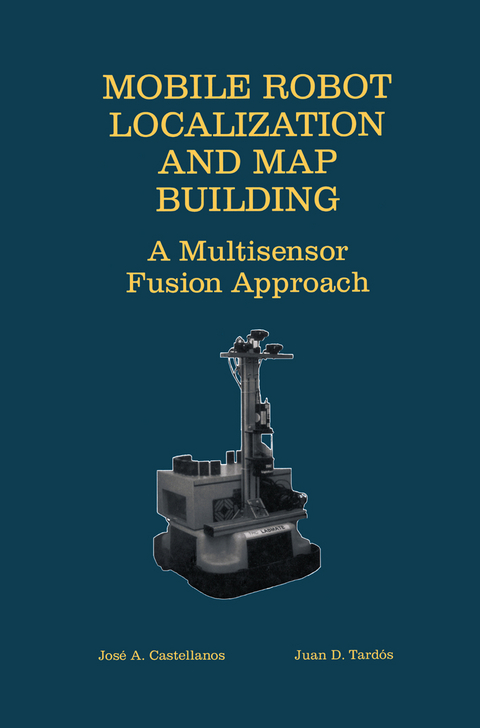
Mobile Robot Localization and Map Building
Springer (Verlag)
978-0-7923-7789-4 (ISBN)
The main problems described throughout this book are:
Representation and integration of uncertain geometric information by means of the Symmetries and Perturbations Model (SPmodel). This model combines the use of probability theory to represent the imprecision in the location of a geometric element, and the theory of symmetries to represent the partiality due to characteristics of each type of geometric element.
A solution to the first location problem, that is, the computation of an estimation for the mobile robot location when the vehicle is completely lost in the environment. The problem is formulated as a search in an interpretation tree using efficient matching algorithms and geometric constraints to reduce the size of the solution space.
The book proposes a new probabilistic framework adapted to the problem of simultaneous localization and map building for mobile robots: the Symmetries and Perturbations Map (SPmap). This framework has been experimentally validated by a complete experiment which profited from ground-truth to accurately validate the precision and the appropriateness of the approach.
The book emphasizes the generality of the solutions proposed to the different problems and their independence with respect to the exteroceptive sensors mounted on the mobile robot. Theoretical results are complemented by real experiments, where the use of multisensor-based approaches is highlighted.
1 Introduction.- 1.1 The First-Location Problem.- 1.2 Simultaneous Localization and Map Building.- 2 Uncertain Geometric Information.- 2.1 Introduction.- 2.2 Models for Geometric Uncertainty.- 2.3 Symmetries and Perturbations Model.- 2.4 Pairing Geometric Features.- 2.5 Suboptimal Estimation Techniques.- 2.6 Summary.- 3 Segment-based Representation of Indoor Environments.- 3.1 Introduction.- 3.2 Representation of Laser Range Readings.- 3.3 2D Laser Segments.- 3.4 Segmentation of Laser Readings.- 3.5 Estimating Edges from Points.- 3.6 Fusion of 2D Laser Edges.- 3.7 Estimating the Length of a Segment.- 3.8 Summary.- 4 Detecting High-Level Features by Multisensor Fusion.- 4.1 Introduction.- 4.2 High Level Features.- 4.3 Processing Monocular Vision Information.- 4.4 Calibration of the Multisensor System.- 4.5 Fusing Laser and Vision.- 4.6 Experimental Results.- 4.7 Summary.- 5 The First-Location Problem.- 5.1 Introduction.- 5.2 Formulation of the First-Location Problem.- 5.3 Geometric Constraints.- 5.4 Matching Algorithms.- 5.5 Estimation of the Mobile Robot Location.- 5.6 Visibility Constraints.- 5.7 Experimenting with Laser Observations.- 5.8 Experimenting with Multisensor Fusion.- 5.9 Summary.- 6 Simultaneous Localization and Map Building.- 6.1 Introduction.- 6.2 The Symmetries and Perturbations Map.- 6.3 Neglecting Correlations.- 6.4 Experimental Results.- 6.5 Navigation in the SPmap.- 6.6 Summary.- 7 Conclusions.- A Transformations and Jacobian Matrices in 2D.- A.1 Homogeneous Matrices and Location Vectors.- A.2 Jacobians of the Composition.- A.3 Jacobian of the Inversion.- A.4 Differential Transformations and Jacobian of a Transformation.- B Operations with Uncertain Locations.- C Geometric Relations.- D Experimental Equipment.- D.1 Mobile Robot OTILIO.- D.2 Mobile Robot VEGA.- D.3 Mobile Robot MACROBE.
| Zusatzinfo | XIII, 205 p. |
|---|---|
| Verlagsort | Dordrecht |
| Sprache | englisch |
| Maße | 155 x 235 mm |
| Themenwelt | Informatik ► Theorie / Studium ► Künstliche Intelligenz / Robotik |
| Technik ► Elektrotechnik / Energietechnik | |
| Technik ► Maschinenbau | |
| ISBN-10 | 0-7923-7789-3 / 0792377893 |
| ISBN-13 | 978-0-7923-7789-4 / 9780792377894 |
| Zustand | Neuware |
| Haben Sie eine Frage zum Produkt? |
aus dem Bereich


